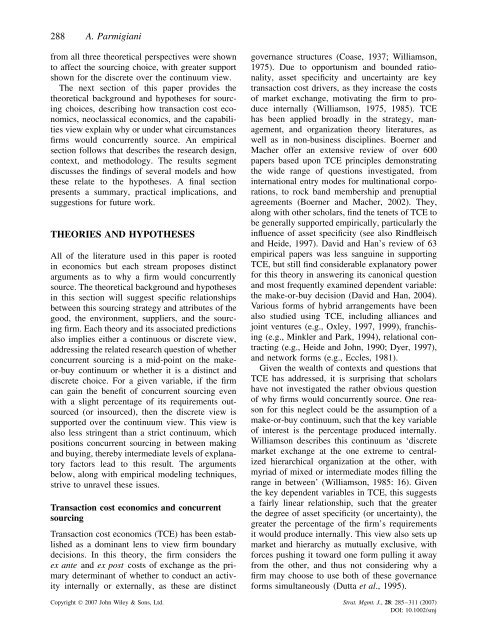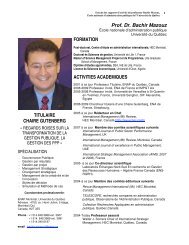Why do firms both make and buy? An investigation of concurrent ...
Why do firms both make and buy? An investigation of concurrent ...
Why do firms both make and buy? An investigation of concurrent ...
You also want an ePaper? Increase the reach of your titles
YUMPU automatically turns print PDFs into web optimized ePapers that Google loves.
288 A. Parmigiani<br />
from all three theoretical perspectives were shown<br />
to affect the sourcing choice, with greater support<br />
shown for the discrete over the continuum view.<br />
The next section <strong>of</strong> this paper provides the<br />
theoretical background <strong>and</strong> hypotheses for sourcing<br />
choices, describing how transaction cost economics,<br />
neoclassical economics, <strong>and</strong> the capabilities<br />
view explain why or under what circumstances<br />
<strong>firms</strong> would <strong>concurrent</strong>ly source. <strong>An</strong> empirical<br />
section follows that describes the research design,<br />
context, <strong>and</strong> metho<strong>do</strong>logy. The results segment<br />
discusses the findings <strong>of</strong> several models <strong>and</strong> how<br />
these relate to the hypotheses. A final section<br />
presents a summary, practical implications, <strong>and</strong><br />
suggestions for future work.<br />
THEORIES AND HYPOTHESES<br />
All <strong>of</strong> the literature used in this paper is rooted<br />
in economics but each stream proposes distinct<br />
arguments as to why a firm would <strong>concurrent</strong>ly<br />
source. The theoretical background <strong>and</strong> hypotheses<br />
in this section will suggest specific relationships<br />
between this sourcing strategy <strong>and</strong> attributes <strong>of</strong> the<br />
good, the environment, suppliers, <strong>and</strong> the sourcing<br />
firm. Each theory <strong>and</strong> its associated predictions<br />
also implies either a continuous or discrete view,<br />
addressing the related research question <strong>of</strong> whether<br />
<strong>concurrent</strong> sourcing is a mid-point on the <strong>make</strong>or-<strong>buy</strong><br />
continuum or whether it is a distinct <strong>and</strong><br />
discrete choice. For a given variable, if the firm<br />
can gain the benefit <strong>of</strong> <strong>concurrent</strong> sourcing even<br />
with a slight percentage <strong>of</strong> its requirements outsourced<br />
(or insourced), then the discrete view is<br />
supported over the continuum view. This view is<br />
also less stringent than a strict continuum, which<br />
positions <strong>concurrent</strong> sourcing in between making<br />
<strong>and</strong> <strong>buy</strong>ing, thereby intermediate levels <strong>of</strong> explanatory<br />
factors lead to this result. The arguments<br />
below, along with empirical modeling techniques,<br />
strive to unravel these issues.<br />
Transaction cost economics <strong>and</strong> <strong>concurrent</strong><br />
sourcing<br />
Transaction cost economics (TCE) has been established<br />
as a <strong>do</strong>minant lens to view firm boundary<br />
decisions. In this theory, the firm considers the<br />
ex ante <strong>and</strong> ex post costs <strong>of</strong> exchange as the primary<br />
determinant <strong>of</strong> whether to conduct an activity<br />
internally or externally, as these are distinct<br />
governance structures (Coase, 1937; Williamson,<br />
1975). Due to opportunism <strong>and</strong> bounded rationality,<br />
asset specificity <strong>and</strong> uncertainty are key<br />
transaction cost drivers, as they increase the costs<br />
<strong>of</strong> market exchange, motivating the firm to produce<br />
internally (Williamson, 1975, 1985). TCE<br />
has been applied broadly in the strategy, management,<br />
<strong>and</strong> organization theory literatures, as<br />
well as in non-business disciplines. Boerner <strong>and</strong><br />
Macher <strong>of</strong>fer an extensive review <strong>of</strong> over 600<br />
papers based upon TCE principles demonstrating<br />
the wide range <strong>of</strong> questions investigated, from<br />
international entry modes for multinational corporations,<br />
to rock b<strong>and</strong> membership <strong>and</strong> prenuptial<br />
agreements (Boerner <strong>and</strong> Macher, 2002). They,<br />
along with other scholars, find the tenets <strong>of</strong> TCE to<br />
be generally supported empirically, particularly the<br />
influence <strong>of</strong> asset specificity (see also Rindfleisch<br />
<strong>and</strong> Heide, 1997). David <strong>and</strong> Han’s review <strong>of</strong> 63<br />
empirical papers was less sanguine in supporting<br />
TCE, but still find considerable explanatory power<br />
for this theory in answering its canonical question<br />
<strong>and</strong> most frequently examined dependent variable:<br />
the <strong>make</strong>-or-<strong>buy</strong> decision (David <strong>and</strong> Han, 2004).<br />
Various forms <strong>of</strong> hybrid arrangements have been<br />
also studied using TCE, including alliances <strong>and</strong><br />
joint ventures (e.g., Oxley, 1997, 1999), franchising<br />
(e.g., Minkler <strong>and</strong> Park, 1994), relational contracting<br />
(e.g., Heide <strong>and</strong> John, 1990; Dyer, 1997),<br />
<strong>and</strong> network forms (e.g., Eccles, 1981).<br />
Given the wealth <strong>of</strong> contexts <strong>and</strong> questions that<br />
TCE has addressed, it is surprising that scholars<br />
have not investigated the rather obvious question<br />
<strong>of</strong> why <strong>firms</strong> would <strong>concurrent</strong>ly source. One reason<br />
for this neglect could be the assumption <strong>of</strong> a<br />
<strong>make</strong>-or-<strong>buy</strong> continuum, such that the key variable<br />
<strong>of</strong> interest is the percentage produced internally.<br />
Williamson describes this continuum as ‘discrete<br />
market exchange at the one extreme to centralized<br />
hierarchical organization at the other, with<br />
myriad <strong>of</strong> mixed or intermediate modes filling the<br />
range in between’ (Williamson, 1985: 16). Given<br />
the key dependent variables in TCE, this suggests<br />
a fairly linear relationship, such that the greater<br />
the degree <strong>of</strong> asset specificity (or uncertainty), the<br />
greater the percentage <strong>of</strong> the firm’s requirements<br />
it would produce internally. This view also sets up<br />
market <strong>and</strong> hierarchy as mutually exclusive, with<br />
forces pushing it toward one form pulling it away<br />
from the other, <strong>and</strong> thus not considering why a<br />
firm may choose to use <strong>both</strong> <strong>of</strong> these governance<br />
forms simultaneously (Dutta et al., 1995).<br />
Copyright © 2007 John Wiley & Sons, Ltd. Strat. Mgmt. J., 28: 285–311 (2007)<br />
DOI: 10.1002/smj





